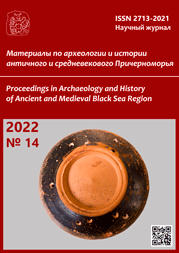Античные монеты, найденные близ пос. Почтовое (Крым), как исторический источник
Antique coins found near of the Poshtove village (Crimea) as a historical source
Author(s): D.V. Andriyevskiy, Mikhail M. ChorefSubject(s): History, Archaeology, Ancient World
Published by: Нижневартовский государственный университет
Keywords: archaeology; history; numismatics; Alma Valley; imported coin;
Summary/Abstract: Our attention was drawn to a small sample of antique coins (10 items) found at the beginning of this century by residents of the town of Poshtove, on the territory of the nearby garden. There are some reasons to believe that these artifacts were once owned by the inhabitants of late Scythian settlements: Alma, Terek-Eli, or an as yet unexplored site located in the area where coins were discovered. The earliest finds are the billon tetradrachms minted in Alexandria under Nero and in honor of Titus under Vespasian. All other coins are change coins made of low-value bronze alloys. Most of them (seven items) were issued in the Eastern Roman provinces in the 2nd — early 3rd cc. The latest of these was minted in Alexandria on behalf of Galerius during the reign of Diocletian. It is noteworthy that there are no coins of Chersonesos and Bosporus in the sample. Moreover, their inhabitants did not use money minted in Roman Egypt. Consequently, the studied artifacts came to the late Scythians not from Chersonesites and Bosporans or foreign merchants who traded in Taurica, but from Roman legionnaires transferred to the peninsula and apparently located in Alma-Kermen. The fact that most of the coins found were issued in the 2nd — early 3rd cc. testifies to the peak of the foreign policy of the Empire in Taurica at that time. In turn, the bronze of Galerius could have come to the region in the process of frontier petty trade. The very fact that these artifacts were discovered in a region of Southwestern Taurica quite far from the coast allows us to clarify our understanding of the economy of the region in the Roman period of its history. There is every reason to believe that its inhabitants traded with the territories controlled by the Romans. Moreover, they valued money not only made of precious metals, but also from bronze.
Journal: Материалы по археологии и истории античного и средневекового Причерноморья
- Issue Year: 2022
- Issue No: 14
- Page Range: 358-368
- Page Count: 11
- Language: Russian

